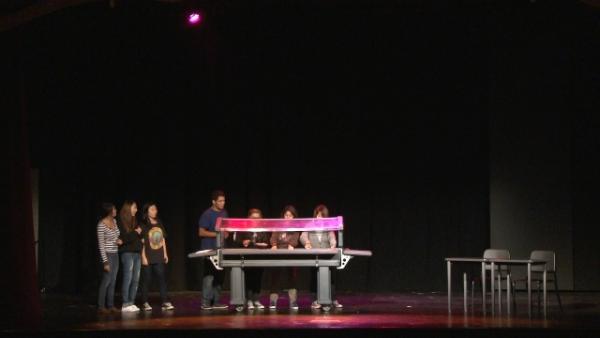Salad Bars in Los Angeles Schools: How Can You Follow Their Lead?
Imagine it is lunchtime and kids are running on empty. They rush into the lunch line, but instead of reaching for chicken nuggets and pizza, students are decorating their trays with brightly colored vegetables and fruits like red cherry tomatoes, green broccoli, black beans, and oranges. This isn’t just a dream, it is actually happening in the Los Angeles Unified School District (LAUSD).

High school students from LAUSD’s Los Angeles High School of the Arts teach elementary and middle school kids how to correctly and safely use a salad bar through a skit called Salad Bar Manners.
LAUSD, the second largest school district in the United States, serves as a great example for how to integrate healthy eating habits into everyday school routines. With the help of Let’s Move Salad Bars to Schools (LMSB2S), the salad bar program at LAUSD shows what can happen when students and parents take initiative to support healthy eating in school cafeterias. Are you inspired by LAUSD? Take a look at how you can help make this a reality within schools in your community.
Are you a student? Positive changes in your school start with you. If you don’t have a salad bar, begin by talking to other students and ask them how they feel about food options during lunch, what they would like to see served, and their thoughts on having a salad bar. In a survey conducted at Robert F. Kennedy Community Schools (RFK) in LAUSD, students eagerly asked for healthier food options. Paper or video surveys and petitions are great ways to get input from your peers. Share these ideas and suggestions with cafeteria staff, the principal, or the district’s nutrition services director.
Another way to support upgrading cafeteria food is to join forces with your student council or student body government. With their help, you can advertise the benefits of salad bars through colorful signs, posters, and organized events like salad bar tryouts or a "Fruit and Vegetable Day".
If your school already has a salad bar, get other students involved and increase salad bar awareness through leadership, art or drama—fourth and fifth grade nutrition ambassadors at RFK agreed that the best strategy to support salad bars was to lead by example. One student said, “I’m going to be the leader. When I go through the salad bar line, I will show the other kids how to choose healthy options and maybe they will follow and want to try something new.” Similarly, Los Angeles High School of the Arts' students became mini-celebrities at RFK after organizing and performing “Salad Bar Manners,” a skit for elementary and middle school students about salad bar etiquette. The children’s immediate response—“When is the next one?”
Are you a parent? If you have free hours during the day, support cafeteria staff and the salad bar program by volunteering as a lunch monitor. Help students choose an appropriate meal by encouraging them to try a new color from the fruit and vegetable rainbow. This will generate enthusiasm and increase their awareness and acceptance of the salad bar. At LAUSD’s Gulf Elementary School, parents volunteer every day. Parent representative Maria Garibay said, “We have parents walking kids over to the salad bars. We talk about vegetables in a way [that] teaches the children and gets them excited to try new lunch options. By the time the students move to the hot lunch line, they are already eating their fruits and vegetables from the salad bar.”
Encourage your school’s Parent Teacher Association/Organization (PTA/O) to support salad bars in your district. Many PTA/O’s have experience with school fundraising efforts and can help connect schools to local community organizations for financial support. For example, people love to gather around a table and enjoy good food. Choose any meal—breakfast, lunch, or dinner—and help organize a fundraising meal in the school cafeteria such as a pancake breakfast or a Friday night dinner starring a salad bar. Combine this meal with another activity like a student concert or an informational session. Learn more about fundraising ideas and tips. Working with school staff and the food services department to encourage acceptance and the use of salad bars can positively affect how people think about healthy foods and inspire other community members to get involved.
Get students excited about fresh fruits and vegetables. Organize a salad bar tasting prior to its opening or organize field trips to local farmers’ markets. If your child’s school already has a salad bar, challenge students to meet their MyPlate goal to make half their plate fruits and vegetables. Work with school staff to create a system where students who eat at the salad bar are awarded a “token.” At the end of each month, students from the class with the most tokens can win extra recess or art time.
How you can find out more. Visit Let’s Move Salad Bars to Schools to learn more. LMSB2S is a public health effort to mobilize and engage stakeholders at the local, state, and national levels to significantly increase the number of salad bars in schools across the country until every child has the choice of healthy fruits and vegetables every day at school. Currently more than 1,000 schools have received salad bars from LMSB2S. Learn how to apply for a salad bar grant for your school.
